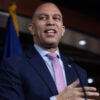“We all know from the research, from the history, that it is free markets that do what we all want and provide what we all want to have as a country,” says Chris Cargill of the Washington Policy Center. “And yet younger generations, many of whom were born after the fall of the Berlin Wall, are looking more longingly toward this socialism idea.”
Now the Washington Policy Center is trying to change how young adults perceive socialism and free markets with the “Free Market Destroy” campaign. The free market, Cargill explains, “destroys all the things that we hate, that especially younger generations hate, like climate change, high rents, hunger, disease, boredom, all the things that we as a society despise and want to improve upon.”
Listen to the interview or read the lightly edited transcript, pasted below.
We also cover these stories:
- Close to 100 million Americans cast their votes before Election Day.
- Businesses around the country are boarding up their windows in anticipation of post-election violence.
- The U.S. Marshals Service found 27 missing children in Virginia.
“The Daily Signal Podcast” is available on Ricochet, Apple Podcasts, Pippa, Google Play, and Stitcher. All of our podcasts can be found at DailySignal.com/podcasts. If you like what you hear, please leave a review. You also can leave us a message at 202-608-6205 or write us at [email protected].
Rachel del Guidice: We’re joined today on “The Daily Signal Podcast” by Chris Cargill, he’s the Eastern Washington director at Washington Policy Center. Chris, it’s great to have you with us on “The Daily Signal Podcast.”
Chris Cargill: My pleasure. Thanks for having me.
Rachel del Guidice: Well, to start off, can you tell us about what Washington Policy Center does and then can you outline your new marketing campaign, the “Free Markets Destroy” marketing campaign, and talk a little bit about why it’s called that?
Cargill: Yeah, absolutely. Washington Policy Center is one of the organizations that is known as a state think tank. So, obviously, Heritage Foundation, Brookings [Institution], American Enterprise Institute, those are all national think tanks. We do basically what those organizations do at a statewide level.
So we exist in Washington state, up in the upper left-hand corner of the country, and we have different research centers that look at things like agriculture, education, environment, government reform, health care, small business, transportation, worker rights issues as well.
We’ve been in existence now for more than 20 years, have a statewide staff of more than 20, and an annual budget of a little more than $4 million. So we’ve seen great success, great growth in our states. And like other state think tanks, other members of the movement, we are trying to position ourselves to have even greater success here in the next decade.
As far as Free Markets Destroy goes, this is a new marketing campaign that we’ve put together at Washington Policy Center to really address what we think is the main issue, if not one of the top issues, that we should all be aware of, and that is this fascination with and interest by younger generations, specifically millennials and Gen Zs, to look at socialism in a great light or in a light that they think that they would be better for the country.
We all know from the research, from the history, that it is free markets that do what what we all want and provide what we all want to have as a country. And yet younger generations, many of whom were born after the fall of the Berlin Wall, are looking more longingly toward this socialism idea.
So about a year ago, we had an idea internally to come up with a marketing campaign. And at that time we were going to call it “Free Markets Create.” We were going to focus on marketing to younger people, to young professionals, to millennials, to Gen Zs, all the great things that the free market creates.
And we put out a national RFP on this and asked firms all across the country, “If you had a certain amount of money, what would you do? What would be the best way to target young professionals and these younger generations with this message?”
We got back your typical marketing campaign, go on TV, go on radio, talk about how great capitalism is, how great the free market is, this kind of red, white, and blue patriotic-type vision.
Then we also got back a proposal from a marketing firm, creative studio, in Austin, Texas, called Emergent Order. And they came back with something completely different, something that was completely unexpected.
They said, instead of talking about what the free market creates, you need to talk about and take a page from what we all kind of know in the back of our mind is creative destruction. What the free market destroys.
In other words, it destroys all the things that we hate, that especially younger generations hate, like climate change, high rents, hunger, disease, boredom, all the things that we as a society despise and want to improve upon.
If you want to change those things and do it in the quickest way possible, you look toward the free market to do that. It’s not going to be government solutions. It’s not going to be socialism that makes it successful. It’s going to be the marketplace. It is the most revolutionary force for change that the world has ever seen.
And so we’re bringing that message to them in that way, that free markets are what you want to look toward to destroy the things that you hate and create something better.
Del Guidice: Well, as you had said, this campaign is targeted to engage millennials and Generation Z. How specifically are you trying to reach out to engage them?
Cargill: Yeah, it’s an interesting question because at first, as I mentioned, a lot of people thought, “Well, just go up on TV, just go up on radio, and that will permeate down to the folks that you’re trying to reach.” That wasn’t going to work, as we all know.
Those younger generations exist on social media. They exist on Facebook. They exist on Instagram. They’re on TikTok. They’re on Snapchat, all of these different social media-type platforms. That’s where the younger generations are and where they’re getting their news from.
So we’ve adjusted our campaign to basically do nothing but social media. We did a few billboards right at the very beginning just to get the buzz going, but all the rest of it has been on social media, targeting specifically millennials and Gen Zs, telling them about this particular issue of what the free market can destroy, and create, and improve in their lives.
And we’ve been enormously successful. We just launched this over the past few months officially, and we’ve reached more than 8 million social media accounts, most of them in Washington state, a few of them outside, but most of them in Washington state—1.3 million millennials and Gen Zs have seen this message in our state.
Just to give you an idea of the universe of millennials and Gen Zs in Washington state, it’s close to about 2 million. So we’ve reached almost three-quarters of them so far and we’re not done, obviously. 1.2 million people in those demographics have interacted with the campaign, and then more than 1 million people have seen one of our Free Markets Destroy video.
So this is just in Washington state. Obviously, if this were to go nationwide, it would be even more successful with people tuning in and trying to figure out exactly what this messaging means, and then learning about what the free market can creatively destroy.
Del Guidice: On the flip side, Chris, what’s the alternative to not reaching out and engaging millennials and Generation Z on these issues?
Cargill: Yeah, I think the alternative is that we lose generations and we have a very different country for the next few decades.
As I mentioned, a lot of these people were born after the fall of the Berlin Wall, so they really have no idea what the ramifications of socialism are. They hear about perhaps what they deem as, or what some politicians see as, benefits, but they really don’t know of the huge, dangerous pitfalls of socialism.
So if we just wave the white flag and say, “OK, well, we’ve lost these generations,” that will have huge ramifications on public policy in not only our state, but throughout the entire country.
Del Guidice: As you also mentioned, Chris, you all released a new video. Well, you have released one very recently, and then the first one, both on different topics. Can you delve a little bit more into the message of both of those videos?
Cargill: Yeah. So the first video, which is about a minute long—and you can find it on YouTube, you can find it on Free Markets Destroy, which is the Facebook page; you go to one of those two places, you’ll see this video—it’s been shared throughout the country and watched more than 360,000 times at the moment that we recorded this interview.
It just talks about basically what the free market destroys. It destroys the things, as I mentioned, that we hate. Pandemics, and hunger, and climate change, and all of the things that we hate.
This basically is a primer for the campaign. You want to hear about what the free market creatively destroys? You can watch this video and get it within a minute time. The other video is more of a dive deeper into Free Markets Destroy and what exactly is a free market.
If you go out on the street and just ask people to give you a definition of the free market, the definitions will be all over the map. You’ll get a lot of people who will say, “Yeah, that market, you’re talking about the stock market, right?” Or, they won’t know necessarily what free market means.
So this longer video that we’ve put together tries to explain that, tries to explain the value of the free market, and what exactly the definition of the free market is.
And basically, that definition boils down to three things. One, you don’t hurt other people or steal their stuff. Two, you keep your word. And then three, there’s no permission required. In other words, you’re free to try, you’re free to buy, and you’re free to leave. That is the essential freedom in free markets.
So those are the differences between the two videos. But [they] are two great tools that I think anybody could use, college professors, or anyone throughout the country, to try to explain what the market is.
Del Guidice: For how long, Chris, will this campaign last and how are young people responding so far?
Cargill: Yeah, it’s an interesting question. I’ll take the second one first. Young people are responding in ways that I don’t think we necessarily imagined.
What’s interesting is we kind of have a real-life focus group going here, where older generations might not understand the messaging, but younger generations, when they hear it, it clicks with them.
And when Emergent Order came to us with this idea of Free Markets Destroy, I have to admit we were a little bit taken aback by it as well. And I think part of the reason for that is because not all of us in our office are in the targeted demographic. Whereas once this went up on social media, the targeted demographic started responding and responding in droves. And that’s exactly what we were hoping for.
As far as how long this will go on, look, we didn’t get into the situation overnight where younger generations are more interested in socialism and probably not going to get out of it overnight. So this is going to continue for quite some time.
The education piece really never ends. And we’re doing, with the social media campaign, we’re doing what we call the two E’s, we’re educating people and we’re engaging people.
The engagement piece allows us to take the names of the people who got signed up or target social media and allow them to be invited to, let’s say, an event we do on climate change, a debate, let’s say, that we do on climate change at the University of Washington, or let’s say we’re going to debate free markets and destroying disease and health care at Gonzaga University.
It allows us to reach out to those people and say, “Hey, you’ve clicked on this campaign. Now, why don’t you come in person, once we are able to start doing events in person again, and hear more about this particular message?”
Del Guidice: Chris, I do want to follow up and ask, are there any personal stories maybe of those who you [have] reached out to in this campaign that you’ve heard from, or maybe someone in your organization has spoken with, about how their minds might have been changed, or maybe instances where your campaign has provoked more discussion and dialogue?
Cargill: Yeah, it’s a great question, and I think the answer is yes. And there are a lot of incidents that we don’t necessarily know about. There are a lot that are anecdotal, and then there are a lot that we know from personal experience.
So what was interesting is that if you go onto the Free Markets Destroy Facebook page, you have the opportunity to purchase some Free Markets Destroy products. So they might be a T-shirt that says “Free Markets Destroy Climate Change,” or it might be a hat, or a coffee mug, or something.
We’ve heard from several people, including some folks who work at media outlets throughout our state, that they have taken those products and have gone out in public wearing them, and it has provoked a conversation, let’s say, with the gas station worker, or with some person that they just met at the library, or some person that they were just standing next to at a bus stop. It has provoked that conversation.
The other interesting note about this is that when people see it initially, they don’t necessarily know what it is. And so sometimes you get the perhaps more socialist person, a more left-leaning person, who says, “Yeah, I agree that free markets destroy climate change. That’s exactly right.”
And then you kind of see the wheels turning and they figure out that the messages that the free market is what is destroying climate change and improving our air quality and environment. It is not necessarily socialism.
So that has been an interesting reaction to the campaign that we’ve seen play out several times, and I think it will just continue to play out as people buy more and more of these products, which fund the campaign, by the way, and then go out in public, or perhaps give a “Free Markets Destroy High Rents” or “Free Markets Destroy Disease” T-shirt or sweatshirt to the Gen Z or the millennial that’s in their life.
Del Guidice: Then lastly, Chris, is there anything else you would encourage listeners to keep in mind as you are working on this campaign and maybe as listeners might want to get involved themselves?
Cargill: Yeah, absolutely. And we’re hoping people do get involved. The success of a campaign like this depends on people liking it, depends on people sharing it.
If you’re going to get a viral post or a viral campaign going, you got to have people all across the country who are willing to listen in, sign up, and then share.
So a couple of things, I would ask everyone listening to go onto their Facebook page, search for Free Markets Destroy, like that page, share it with other people, share the videos. The videos are huge conversation starters. And if you share the video, you have a great chance of influencing those in your sphere.
Second thing, go to freemarketsdestroy.com, sign up for what is called the Destroy Download, which is our weekly email that you can get to link to our blog that finds out more about what the free market is destroying and improving in our life.
And then the third thing is, I mentioned just a few minutes ago, you can go to the Facebook page … or freemarketsdestroy.com and you can purchase products on there to give to people in your life to help us spread the message.
So those really are the ways that you can get involved, the ways that you can help us out with the campaign. And as I mentioned, the success of this campaign, especially nationally, is going to depend on people who are in the movement that are supportive of free markets and capitalism sharing it with their networks.
Del Guidice: Well, Chris, thank you so much for joining us on “The Daily Signal Podcast” and talking to us about the Free Markets Destroy campaign. It’s been great having you with us.
Cargill: My pleasure. Thanks for having me.
































